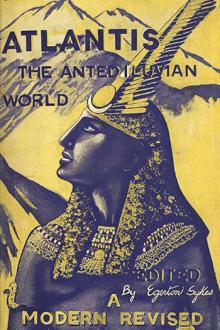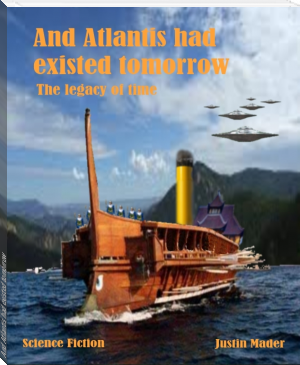Atlantis: The Antedeluvian World by Ignatius Donnelly (thriller novels to read .TXT) 📕

- Author: Ignatius Donnelly
- Performer: -
Book online «Atlantis: The Antedeluvian World by Ignatius Donnelly (thriller novels to read .TXT) 📕». Author Ignatius Donnelly
It is a still more remarkable fact that a comparison of the flora of the Old World and New goes to show that not only was there communication by land, over which the plants of one continent could extend to another, but that man must have existed, and have helped this transmigration, in the case of certain plants that were incapable of making the journey unaided.
Otto Kuntze, a distinguished German botanist, who has spent many years in the tropics, announces his conclusion that “In America and in Asia the principal domesticated tropical plants are represented by the same species.” He instances the Manihot utilissima, whose roots yield a fine flour; the tarro (Colocasia esculenta), the Spanish or red pepper, the tomato, the bamboo, the guava, the mango-fruit, and especially the banana. He denies that the American origin of tobacco, maize, and the cocoa-nut is proved. He refers to the Paritium tiliaceum, a malvaceous plant, hardly noticed by Europeans, but very highly prized by the natives of the tropics, and cultivated everywhere in the East and West Indies; it supplies to the natives of these regions so far apart their ropes and cordage. It is always seedless in a cultivated state. It existed in America before the arrival of Columbus.
But Professor Kuntze pays especial attention to the banana, or plantain.
The banana is seedless. It is found throughout tropical Asia and Africa.
Professor Kuntze asks, “In what way was this plant, which cannot stand a voyage through the temperate zone, carried to America?” And yet it was generally cultivated in America before 1492. Says Professor Kuntze, “It must be remembered that the plantain is a tree-like, herbaceous plant, possessing no easily transportable bulbs, like the potato or the dahlia, nor propagable by cuttings, like the willow or the poplar. It has only a perennial root, which, once planted, needs hardly any care, and yet produces the most abundant crop of any known tropical plant.” He then proceeds to discuss how it could have passed from Asia to America. He admits that the roots must have been transported from one country to the other by civilized man. He argues that it could not have crossed the Pacific from Asia to America, because the Pacific is nearly thrice or four times as wide as the Atlantic. The only way he can account for the plantain reaching America is to suppose that it was carried there when the North Pole had a tropical climate! Is there any proof that civilized man existed at the North Pole when it possessed the climate of Africa?
Is it not more reasonable to suppose that the plantain, or banana, was cultivated by the people of Atlantis, and carried by their civilized agricultural colonies to the east and the west? Do we not find a confirmation of this view in the fact alluded to by Professor Kuntze in these words: “A cultivated plant which does not possess seeds must have been under culture for a very long period—we have not in Europe a single exclusively seedless, berry-bearing, cultivated plant—and hence it is perhaps fair to infer that these plants were cultivated as early as the beginning of the middle of the Diluvial Period.”
Is it possible that a plant of this kind could have been cultivated for this immense period of time in both Asia and America? Where are the two nations, agricultural and highly civilized, on those continents by whom it was so cultivated? What has become of them? Where are the traces of their civilization? All the civilizations of Europe, Asia, and Africa radiated from the Mediterranean; the Hindoo-Aryans advanced from the north-west; they were kindred to the Persians, who were next-door neighbors to the Arabians (cousins of the Phœnicians), and who lived along-side of the Egyptians, who had in turn derived their civilization from the Phœnicians.
It would be a marvel of marvels if one nation, on one continent, had cultivated the banana for such a vast period of time until it became seedless; the nation retaining a peaceful, continuous, agricultural civilization during all that time. But to suppose that two nations could have cultivated the same plant, under the same circumstances, on two different continents, for the same unparalleled lapse of time, is supposing an impossibility.
We find just such a civilization as was necessary, according to Plato, and under just such a climate, in Atlantis and nowhere else. We have found it reaching, by its contiguous islands, within one hundred and fifty miles of the coast of Europe on the one side, and almost touching the West India Islands on the other, while, by its connecting ridges, it bound together Brazil and Africa.
But it may be said these animals and plants may have passed from Asia to America across the Pacific by the continent of Lemuria; or there may have been continuous land communication at one time at Behring’s Strait.
True; but an examination of the flora of the Pacific States shows that very many of the trees and plants common to Europe and the Atlantic States are not to be seen west of the Rocky Mountains. The magnificent magnolias, the tulip-trees, the plane-trees, etc., which were found existing in the Miocene Age in Switzerland, and are found at the present day in the United States, are altogether lacking on the Pacific coast.
The sources of supply of that region seem to have been far inferior to the sources of supply of the Atlantic States. Professor Asa Gray tells us that, out of sixty-six genera and one hundred and fifty-five species found in the forests cast of the Rocky Mountains, only thirty-one genera and seventy-eight species are found west of the mountains. The Pacific coast possesses no papaw, no linden or basswood, no locust-trees, no cherry-tree large enough for a timber tree, no gum-trees, no sorrel-tree, nor kalmia; no persimmon-trees, not a holly, only one ash that may be called a timber tree, no catalpa or sassafras, not a single elm or hackberry, not a mulberry, not a hickory, or a beech, or a true chestnut. These facts would seem to indicate that the forest flora of North America entered it from the east, and that the Pacific States possess only those fragments of it that were able to struggle over or around the great dividing mountain-chain.
We thus see that the flora and fauna of America and Europe testify not only to the existence of Atlantis, but to the fact that in an earlier age it must have extended from the shores of one continent to those of the other; and by this bridge of land the plants and animals of one region passed to the other.
The cultivation of the cotton-plant and the manufacture of its product was known to both the Old and New World. Herodotus describes it (450
B.C.) as the tree of India that bears a fleece more beautiful than that of the sheep. Columbus found the natives of the West Indies using cotton cloth. It was also found in Mexico and Peru. It is a significant fact that the cotton-plant has been found growing wild in many parts of America, but never in the Old World. This would seem to indicate that the plant was a native of America; and this is confirmed by the superiority of American cotton, and the further fact that the plants taken from America to India constantly degenerate, while those taken from India to America as constantly improve.
There is a question whether the potato, maize, and tobacco were not cultivated in China ages before Columbus discovered America. A recent traveller says, “The interior of China, along the course of the Yang-tse-Kiang, is a land full of wonders. In one place piscicultural nurseries line the banks for nearly fifty miles. All sorts of inventions, the cotton-gin included, claimed by Europeans and Americans, are to be found there forty centuries old. Plants, yielding drugs of great value, without number, the familiar tobacco and potato, maize, white and yellow corn, and other plants believed to be indigenous to America, have been cultivated there from time immemorial.”
Bonafous (“Histoire Naturelle du Mais,” Paris, 1826) attributes a European or Asiatic origin to maize. The word maize, (Indian corn) is derived from mahiz or mahis, the name of the plant in the language of the Island of Hayti. And yet, strange to may, in the Lettish and Livonian languages, in the north of Europe, mayse signifies bread; in Irish, maise is food, and in the Old High German, maz is meat. May not likewise the Spanish maiz have antedated the time of Columbus, and borne testimony to early intercommunication between the people of the Old and New Worlds?
It is to Atlantis we must look for the origin of nearly all our valuable plants. Darwin says (“Animals and Plants under Domestication,” vol. i., p. 374), “It has often been remarked that we do not owe a single useful plant to Australia, or the Cape of Good Hope—countries abounding to an unparalleled degree with endemic species—or to New Zealand, or to America south of the Plata; and, according to some authors, not to America north of Mexico.” In other words, the domesticated plants are only found within the limits of what I shall show hereafter was the Empire of Atlantis and its colonies; for only here was to be found an ancient, long-continuing civilization, capable of developing from a wild state those plants which were valuable to man, including all the cereals on which to-day civilized man depends for subsistence. M. Alphonse de Candolle tells us that we owe 33 useful plants to Mexico, Peru, and Chili. According to the same high authority, of 157 valuable cultivated plants 85 can be traced back to their wild state; as to 40, there is doubt as to their origin; while 32 are utterly unknown in their aboriginal condition. (“Geograph. Botan. Raisonnée,” 1855, pp. 810-991.) Certain roses—the imperial lily, the tuberose and the lilac—are said to have been cultivated from such a vast antiquity that they are not known in their wild state. (Darwin, “Animals and Plants,” vol. i., p.
370.) And these facts are the more remarkable because, as De Candolle has shown, all the plants historically known to have been first cultivated in Europe still exist there in the wild state. (Ibid.) The inference is strong that the great cereals—wheat, oats, barley, rye, and maize—must have been first domesticated in a vast antiquity, or in some continent which has since disappeared, carrying the original wild plants with it.
CEREALS OF THE AGE OF STONE IN EUROPEDarwin quotes approvingly the opinion of Mr. Bentham (“Hist. Notes Cult.
Plants”), “as the result of all the most reliable evidence that none of the Ceralia—wheat, rye, barley, and oats—exist or have existed truly wild in their present state.” In the Stone Age of Europe five varieties of wheat and three of barley were cultivated. (Darwin, “Animals and Plants,” vol. i., p. 382.) He says that it may be inferred, from the presence in the lake habitations of Switzerland of a variety of wheat known as the Egyptian wheat, and from the nature of the weeds





Comments (0)